DER ERSTE SCHWELLKASTEN, DER NICHT DER ERSTE WAR
Keywords:
iberian organ music, swell-box, echo, using of the swell-box, performance practice, crescendo, decrescendo, Martín y Coll, Flores de MúsicaAbstract
The swell-box first appeared on the Iberian peninsula in the 17th century. Its origin and European influence has hardly been revealed adequately so far. Though this article mentions the history of the English and German swell-boxes, it focuses on the types of the Hispanic echo-boxes, their different kinds of moving mechanisms (estribo, zapata, rodillera). Bibliography usually says that the mechanism was used for emphasizing the opposition of nearer and further sounding, a kind of acoustic delusion could be provoked by its usage, not a long lasting crescendo or decrescendo. The article states that the great collection of Fray Martín y Coll denies this supposition. It comes clear that the early 18th century echo-boxes were able to produce accent-like sound effects and slight enhancement of certain harmonies and melodic turns, which is confirmed by a few score sheet examples. The aim of this article is to help further research with relevant questions.References
Baladrón, José Maria Barrero und de Graaf, Gerard A. C., El órgano de Santa Marinala Real de León y la familia de Echavarría, organeros del rey (León: Univ. de León, 2004.) S. 230–231.
Bicknell, Stephen, The History of the English Organ (Cambridge University Press, 1996) S. 154.
Carl Burney's der Musik Doctors Tagebuch einer Musikalischen Reise. [Bd. III]: Durch Böhmen, Sachsen, Brandenburg, Hamburg und Holland, Hamburg 1773. Nachdruck: Charles Burney: Tagebuch einer musikalischen Reise. [Kassel: Bärenreiter Verlag, 2003] S. 68–70.
Busch, Hermann J., “Schwellwerk”. In: Lexikon der Orgel Orgelbau, Orgelspiel, Komponisten und ihre Werke, Interpreten, herausg. Hermann J. Busch und Matthias Geuting (Laaber: Laaber-Verlag, 2007) S. 705–707.
Engel, Hans, “Echo” MGG (1989) Band 3. S. 1080.
Freeman, Andrew, “Renatus Harris's Proposed St. Paul's Organ and his Puzzling Invention”. The Organ 10 (1930) 77., zitiert: David S. Knight (1996) S. 132.
Gillingham, Michael/Plumley, Nicholas/Bicknell, Stephen: „Renatus Harris”, The New Grove Dictionary of Music and Musicians, herausg. Stanley Sadie (London: Grove, 2001) Band 11, S. 49.
Haacke, Walter und Jeahn, Reinhard, “Paul Schmidt und Mecklenburgs Orgelbau im 18. Jahrhundert”, Acta Organologica 18 (1985) S. 248.
Jambou, Louis, “Spanien” In: MGGPrisma, herausg. Alfred Reichling (Kassel: Bärenreiter, 2001) S. 152.
Knight, David S., “The early history of the Swell”, Organ Yearbook 26 (1996) S. 132.
Mandics György–M. Veress Zsuzsanna, Bolyai János jegyzeteiből. [Aus Notizen János Bolyai] (Bukarest: Kriterion, 1979.) S. 57.
Martín y Coll, Antonio, Tonos de Palacio y Canciones Comunes I/II/III, transcripción Julián Sagasta Galdós (Madrid: Edición Unión Musical Española, 1984/1985) S. 51.
Méhes Balázs, “Jövet-menet, avagy echó-effektus és redőnyhatás Hispánia orgo¬nazenéjében” [Ida í venida, oder Echo-Effekt und Wirkung des Schwellers in der Orgelmusik Hispaniens] Studia Caroliensia 10/2–3 (2009) S. 137–152.
Méhes Balázs, “A redőnyszerkezet története a német orgonakultúrában a XIX. század végéig; előzményei, fogadtatása, elterjedésének akadályai, valamint használatának helye az előadói gyakorlatban” [Die Geschichte des Schwellwerks in der deutschen Orgelkultur bis Ende des 19. Jahrhunderts: Vorgaeschichte, Annahme, Hindernisse der Verbreitung, Möglichkeiten der Anwendung in der Aufführungspraxis] – DLA Dissertation, Budapest, 2010. siehe URL:http://www.lisztakademia.hu/netfolder/public/PublicNet/Doktori%20dolgozatok/mehes_balazs/disszertacio.pdf, zur deutschen Zusammenfassung siehe URL:http://www.lisztakademia.hu/netfolder/public/PublicNet/Doktori%20dolgozatok/mehes_balazs/tezis_en.pdf.
Merklin, Albert, Aus Spaniens altem Orgelbau. Mit Beiträgen von Dr. Gonzalo Silva y Ramón, Georges Arthur Hill und ans der “Organologia” von Merklin (Mainz: Rheingold, 1939) S. 25.
Merklin, Albert, “Beiträge zur Geschichte und Entwicklung des Schwellwerkes der Orgeln”, Zeitschrift für Instrumentenbau 45/3 (1925) S. 132–133.
Morath, Christoph Reinhold, “Ein frühes Schwellwerk der Bachzeit in Franken. Zur Ästhetik und Klangtypologie von Johann Christoph Wieglebs Barockorgel in Ansbach/Mittelfranken”, Organ 10/2 (2007) S. 18–19.
Morath Reinhold und Reil, Hans, “Die Wiegleb-Orgel - Konzept und Rekonstruktion.” In: Festschrift zur Einweihung der rekonstruierten Orgel von Johann Christoph Wiegleb (1738) in der ehemalige Hof- und Stiftskirche St. Gumbertus zu Ansbach am 17. Juni 2007. (Ansbach: Kirchengemeinde St. Gumbertus 2007) S. 37.
Reuter, Rudolf, Orgeln in Spanien (Kassel: Bärenreiter, 1986) Bild 68.
Steves, Heinz Herbert, “Der Orgelbauer Joachim Wagner (1690–1749) Schluß”, Archiv für Musikforschung 5/1 (1940) S. 25.
Werckmeister, Andreas, Erweiterte und verbesserte Orgelprobe, oder Eigentliche Beschreibung, wie und welcher Gestalt man die Orgelwercke von der Orgelmachern annehmen, probieren, untersuchen und denen Kirchen liefern könne... (Quedlinburg: T. P. Calvisius, 1698 [2.]) [FA Documenta musicologica 1/30; Kassel: Bärenreiter, 1970, D. R. Moser] S. 51.
Williams, Peter F., “Bach's Fiauti d'Echo” Music&Letter 42/1 (1960) S. 101.
Williams, Peter F., The European Organ 1450–1850 (London: B. T. Batsford, 1966) S. 164. URL: http://www.grenzing.com/images/organ_big/REA_Eco6.jpg.
Downloads
Published
How to Cite
Issue
Section
License
Copyright (c) 2016 Studia Universitatis Babeș-Bolyai Musica

This work is licensed under a Creative Commons Attribution-NonCommercial-NoDerivatives 4.0 International License.






